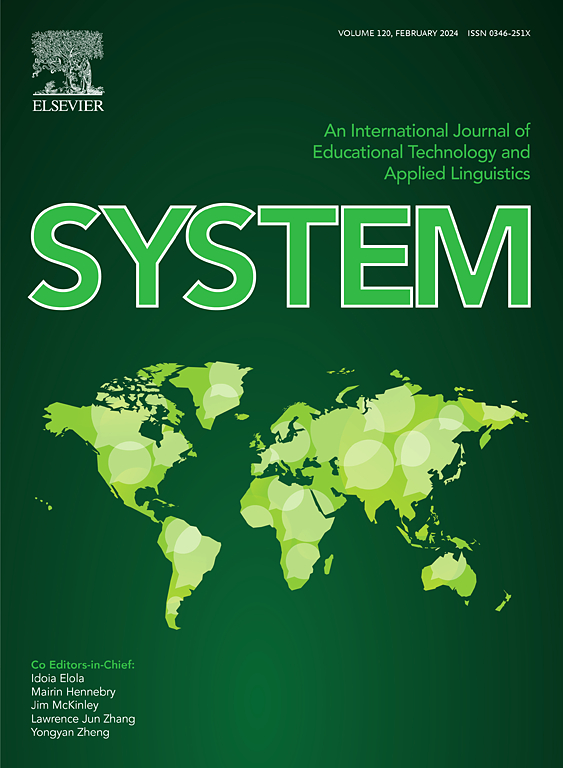NLP-based analysis of verb semantic cohesion in L2 writing: Interaction of genre and proficiency on verb networks
IF 4.9
1区 文学
Q1 EDUCATION & EDUCATIONAL RESEARCH
引用次数: 0
Abstract
Natural language processing (NLP) is a computer-based approach to linguistic analysis that applies algorithmic techniques to textual data, enabling the extraction of complex patterns and the examination of language structures. In second language (L2) writing research, NLP techniques have facilitated increasingly sophisticated analyses of semantic features, extending beyond traditional structural measures to capture deeper mechanisms of meaning construction. While previous studies have explored various dimensions of L2 writing through NLP-based approaches, less attention has been given to how genre influences semantic cohesion, particularly in verb usage. This study investigates genre effects on verb semantic cohesion in L2 writing, using an NLP-based semantic network analysis of narrative and argumentative essays written by higher- and lower-proficiency L2 learners. The semantic network analysis identifies how verbs function as semantic anchors within constructions, illuminating cohesion patterns that reflect writers’ conceptual organization. Results indicated that higher-proficiency writers demonstrated stronger semantic cohesion and more sophisticated verb usage in argumentative essays, characterized by denser and more interconnected verb networks. In contrast, their narrative essays showed less complex networks with concrete action verbs. Lower-proficiency writers exhibited less pronounced differentiation between genres, relying on a restricted range of verbs across both types of writing. These findings suggest that advanced L2 writing proficiency is marked by the ability to adapt verb usage to genre-specific demands, aligning with usage-based approaches to language learning. These findings are discussed in light of their potential implications for L2 writing instruction and assessment, emphasizing the importance of considering semantic cohesion and genre-appropriate verb usage.
基于nlp的二语写作动词语义衔接分析:类型与动词网络熟练度的相互作用
自然语言处理(NLP)是一种基于计算机的语言分析方法,它将算法技术应用于文本数据,从而能够提取复杂的模式和检查语言结构。在第二语言写作研究中,NLP技术促进了越来越复杂的语义特征分析,超越了传统的结构测量,以捕捉更深层次的意义构建机制。虽然以前的研究通过基于自然语言推理的方法探索了二语写作的各个维度,但很少有人关注体裁对语义衔接的影响,特别是在动词使用方面。本研究利用基于nlp的语义网络分析了高水平和低水平的二语学习者所写的叙事性和议论文,探讨了文体对二语写作中动词语义衔接的影响。语义网络分析确定动词如何在结构中充当语义锚点,阐明反映作者概念组织的衔接模式。结果表明,水平越高的作者在议论文中表现出更强的语义衔接和更复杂的动词使用,动词网络更密集、联系更紧密。相比之下,他们的叙事性文章在具体的动作动词中表现出不那么复杂的网络。熟练程度较低的作家表现出不太明显的体裁差异,在两种类型的写作中都依赖于有限范围的动词。这些发现表明,高水平的第二语言写作能力的特点是能够根据特定类型的要求调整动词的用法,与基于用法的语言学习方法相一致。本文讨论了这些发现对二语写作指导和评估的潜在影响,强调了考虑语义衔接和体裁恰当动词使用的重要性。
本文章由计算机程序翻译,如有差异,请以英文原文为准。
求助全文
约1分钟内获得全文
求助全文
来源期刊

System
Multiple-
CiteScore
8.80
自引率
8.30%
发文量
202
审稿时长
64 days
期刊介绍:
This international journal is devoted to the applications of educational technology and applied linguistics to problems of foreign language teaching and learning. Attention is paid to all languages and to problems associated with the study and teaching of English as a second or foreign language. The journal serves as a vehicle of expression for colleagues in developing countries. System prefers its contributors to provide articles which have a sound theoretical base with a visible practical application which can be generalized. The review section may take up works of a more theoretical nature to broaden the background.
 求助内容:
求助内容: 应助结果提醒方式:
应助结果提醒方式:


